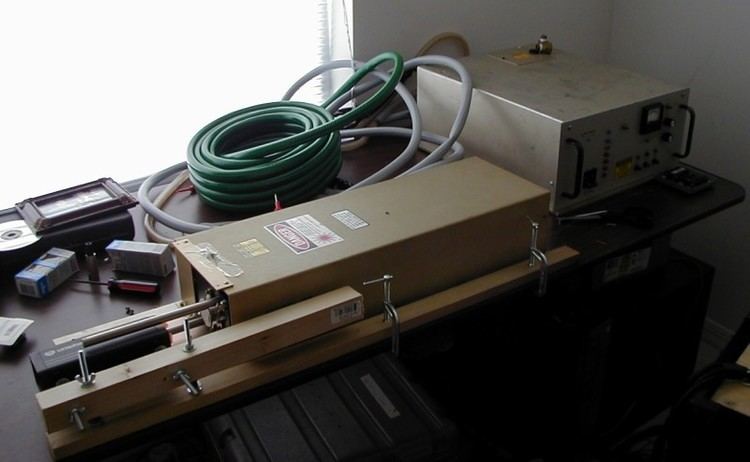 | ||
An ion laser is a gas laser that uses an ionized gas as its lasing medium. Like other gas lasers, ion lasers feature a sealed cavity containing the laser medium and mirrors forming a Fabry–Pérot resonator. Unlike helium–neon lasers, the energy level transitions that contribute to laser action come from ions. Because of the large amount of energy required to excite the ionic transitions used in ion lasers, the required current is much greater, and as a result all but the smallest ion lasers are water-cooled. A small air-cooled ion laser might produce, for example, 130 mW of light with a tube current of 10 A at 105 V. This is a total power draw over 1 kW, which translates into a large amount of heat that must be dissipated.
Contents
Krypton laser
A krypton laser is an ion laser using krypton ions as a gain medium, pumped by electric discharge. Krypton lasers are used for scientific research, or when krypton is mixed with argon, for creation of "white-light" lasers, useful for laser light shows. Krypton lasers are also used in medicine (e.g. for coagulation of retina), for manufacture of security holograms, and numerous other purposes.
Krypton lasers emit at several wavelengths through the visible spectrum: at 406.7 nm, 413.1 nm, 415.4 nm, 468.0 nm, 476.2 nm, 482.5 nm, 520.8 nm, 530.9 nm, 568.2 nm, 647.1 nm, 676.4 nm.
Argon laser
The argon-ion laser was invented in 1964 by William Bridges at Hughes Aircraft and is one of a family of ion lasers that use a noble gas as the active medium.
Argon-ion lasers are used for retinal phototherapy (for diabetes), lithography, and pumping other lasers. Argon-ion lasers emit at 13 wavelengths through the visible, ultraviolet, and near-visible spectrum, including: 351.1 nm, 363.8 nm, 454.6 nm, 457.9 nm, 465.8 nm, 476.5 nm, 488.0 nm, 496.5 nm, 501.7 nm, 514.5 nm, 528.7 nm, 1092.3 nm.
Common argon and krypton lasers are capable of emitting continuous-wave (CW) output of several milliwatts to tens of watts. Their tubes are usually made from nickel end bells, kovar metal-to-ceramic seals, beryllium oxide ceramics, or tungsten disks mounted on a copper heat spreader in a ceramic liner. The earliest tubes were simple quartz, followed by quartz with graphite disks. In comparison with the helium–neon lasers that require just a few milliamperes, the current used for pumping the krypton laser is several amperes, as the gas has to be ionized. The ion laser tube produces a lot of waste heat and requires active cooling.
The typical noble-gas ion-laser plasma consists of a high-current-density glow discharge in a noble gas in the presence of a magnetic field. Typical CW plasma conditions are current densities of 100 to 2000 A/cm2, tube diameters of 1 to 10 mm, filling pressures of 0.1 to 1.0 Torr (0.0019 to 0.019 psi), and an axial magnetic field of the order of 1000 G.
William R. Bennett, the co-inventor of the first gas laser (the helium–neon laser), was the first to observe spectral hole burning effects in gas lasers and created a theory of hole burning effects on laser oscillation. He was co-discoverer of lasers using electron-impact excitation in each of the noble gases, dissociative excitation transfer in the neon–oxygen laser (the first chemical laser), and collision excitation in several metal-vapor lasers.
